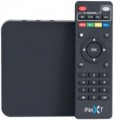Miracast
A wireless technology that allows you to directly broadcast video and audio from one device to another directly over a Wi-Fi connection. At the same time, unlike AirPlay, transmission does not require a router and building a local network — it is enough that the receiver and transmitter are compatible with Miracast. One of the most popular ways to use this technology is to output a “picture” from a smartphone / tablet screen to a TV, and vice versa.
A media centre or TV receiver with Miracast is useful if the TV itself does not support this function.
Coaxial output
In this case, the term
coaxial refers to a type of SP/DIF interface that uses an electrical cable with an RCA connector. This interface provides sound transmission, including multichannel, in digital format; at the same time, the electrical cable is more susceptible to interference than the optical one, but is not as fragile.
Optical output
A variation of the SP/DIF audio interface that uses a TOSLINK fibre optic cable. Like the coaxial connector,
the optical output uses a digital data transfer format and can work with multi-channel audio. At the same time, optical fibre requires rather delicate handling, but it is absolutely insensitive to electrical interference.
CPU frequency
The clock speed of the CPU installed in the media centre.
On the technical side, the higher this indicator, the faster the processor works and the higher, accordingly, the overall system performance. At the same time, the CPU performance depends, in addition to the frequency itself, on a number of factors — architecture, number of cores, special design features, etc.; and the actual speed of the entire system is affected by performance of components other than the processor. In addition, manufacturers usually select processors in such a way that their computing power is guaranteed to be enough for all the features claimed for a media centre. Therefore, in this case, the CPU frequency is more of a reference parameter (and partly an advertising indicator that demonstrates the advanced specifications of the device), rather than practically significant for buyer.
Ultra HD 4K support
The ability to play video in
ultraHD 4K on the device. This format covers several resolutions, all of which have a horizontal size of approximately 4000 pixels. However, the most popular is the frame size of 3840x2160 — in particular, this is the standard value for 4K TV screens; therefore, most UltraHD content is also released in this resolution.
A 3840x2160 frame contains 4 times more pixels than the popular Full HD standard, resulting in an even sharper and more detailed image. Of course, you will need a TV (or other screen) of the appropriate resolution to fully enjoy the experience; but such screens nowadays are becoming more common and affordable.
Audio decoders
The set of audio codecs supported by the device
Codec — from the phrase "Encoder-DEcoder" — in this case, the format used for encoding and compressing sound in digital form during storage/transmission and decoding — during playback (digital sound is basically impossible without encoding, and compression allows to reduce the amount of data). Information about supported codecs is relevant primarily for assessing whether the player will be able to work with sound in a particular video file. The fact is that even in video files of the same format (see below), sound can be compressed by different codecs; and if the player supports the file format, but does not support the codec, sound playback will become impossible.
Theoretically, these rules are also relevant for audio files and online broadcasts (all formats — TV, video, audio). However, in fact, when working with such content, you can ignore codec data. So, for each audio file format, usually, its own standard codec is used, and file type support automatically means codec support. Broadcasts usually use generally accepted audio decoders like MPEG-1 or MPEG-2, which are practically guaranteed to be supported by any modern player designed for such broadcasts.
As for specific codecs, detailed information on them can be found in special sources, however, with the standard use of devices, such details are usually not needed.
